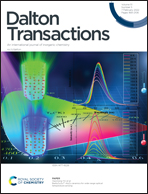Relevance of the electron transfer pathway in photodynamic activity of Ru(ii) polypyridyl complexes containing 4,7-diphenyl-1,10-phenanthroline ligands under normoxic and hypoxic conditions†
Abstract
The purpose of this study was to investigate the correlation between the spectroscopic and photophysical properties of Ru(II) polypyridyl complexes and their photodynamic activity in vitro. A series of Ru(II) polypyridyl complexes with 4,7-diphenyl-1,10-phenanthroline (dip) and 2,3-bis(2-pyridyl)quinoxaline (dpq) and its derivatives were synthesized and characterized regarding their photophysical, biological, and photodynamic properties. The complexes were evaluated not only in the context of 1O2 generation but also regarding other types of reactive oxygen species (ROS) to assess the possibility of Ru(II) complexes to induce phototoxicity via various ROS using fluorescence and EPR spectroscopy. The compounds were found to be moderately cytotoxic with IC50 values ranging from 1 to 35 μM and retained their cytotoxic activity under hypoxic conditions. The unraveled phototoxic activity is based mainly on the generation of H2O2 and 1O2, highlighting the importance of electron-transfer processes in the observed photodynamic activity of Ru polypyridyl complexes. A combination of photodynamic activity with cytotoxicity under decreased dioxygen concentrations may help overcome the current photodynamic therapy (PDT) limitation. The findings highlight the need for broadening the scope of tested Ru-based photosensitizers.



 Please wait while we load your content...
Please wait while we load your content...